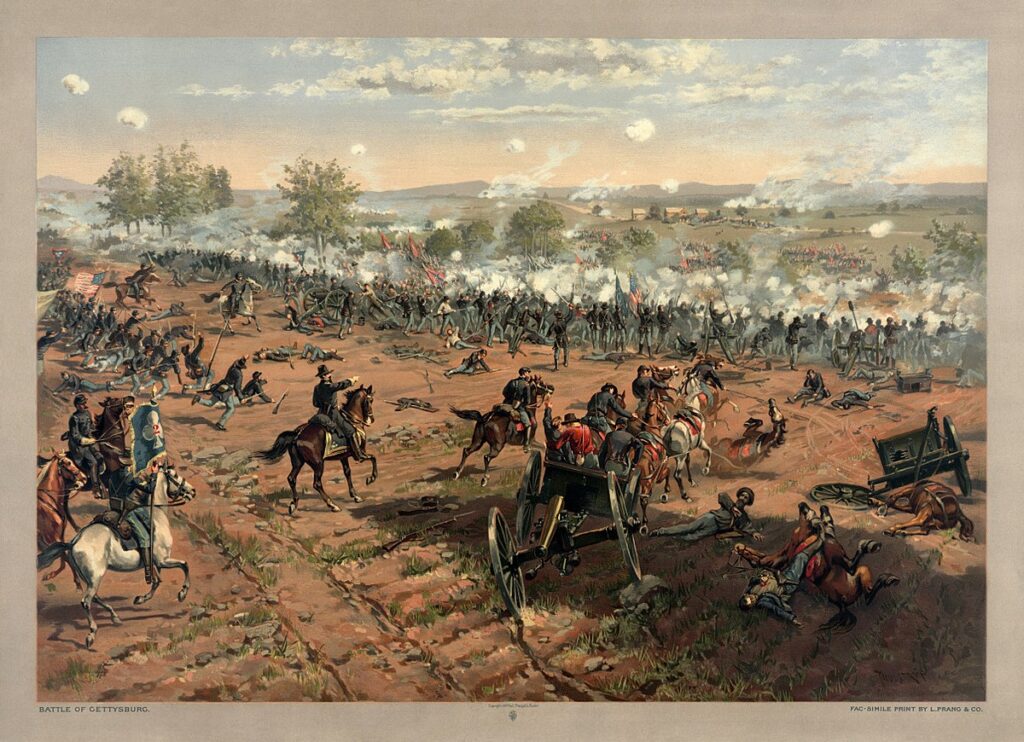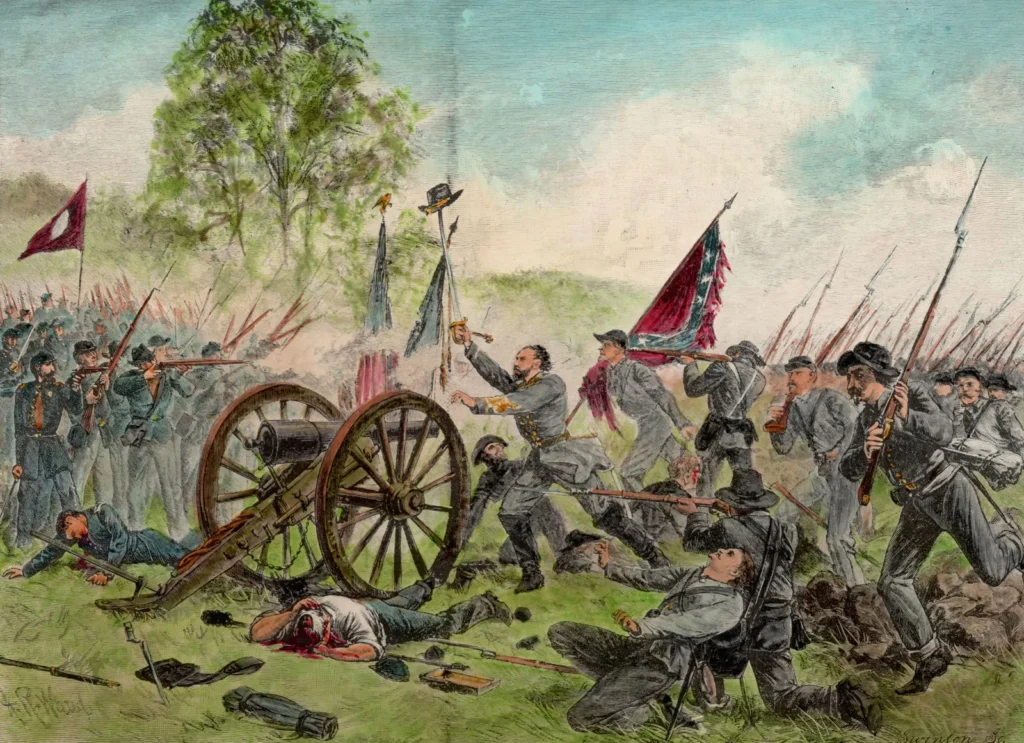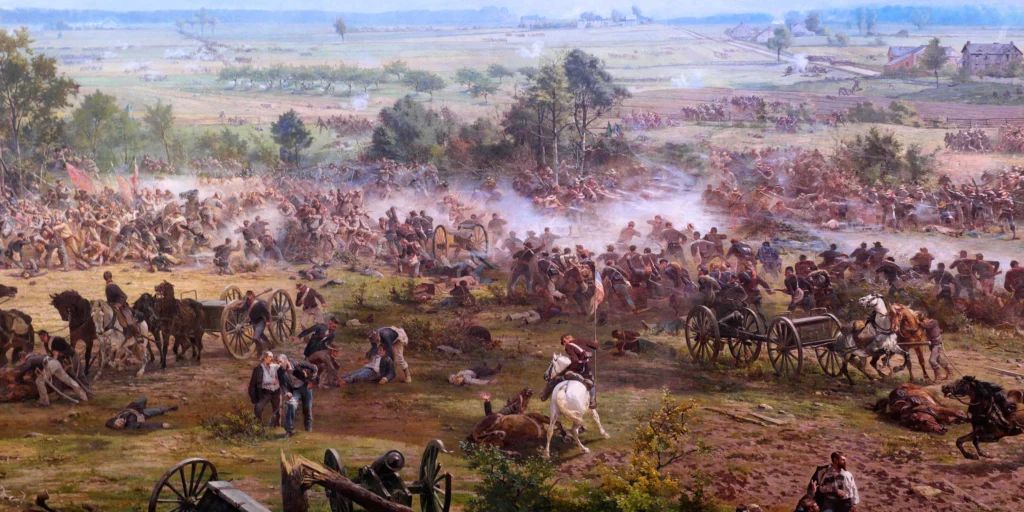The American Civil War was a four-year conflict that took place from 1861 to 1865, and was fought between the United States of America (known as the Union) and 11 Southern states who seceded and formed the Confederate States of America. The main cause of the war was the disagreement between the two sides over the issue of slavery and states’ rights. The Confederacy aimed to protect the institution of slavery, while the Union aimed to abolish it. The conflict was initiated by the Confederate attack on Fort Sumter located in South Carolina.
The Union ultimately emerged as the victor of the war, leading to the abolition of slavery in the United States and the reunification of the country. The war resulted in a substantial human toll, with the estimated casualties ranging from 620,000 to over 700,000.
The aftermath of the war brought significant changes to the country, including the ratification of the 13th, 14th, and 15th Amendments to the US Constitution. These amendments provided former slaves with citizenship and voting rights, and ensured equal protection under the law for all individuals. The American Civil War was a transformative event in the country’s history, and had a profound impact on shaping the future course of the nation and advancing the cause of civil rights and equality.
Events of the Civil War
The American Civil War (1861-1865) was a complex and defining period in American history that was marked by a number of key events and battles.
- Secession of the Southern States: In the months leading up to the outbreak of the war, 11 southern states declared their secession from the United States and formed the Confederate States of America.
- Attack on Fort Sumter: On April 12, 1861, Confederate forces attacked the Union-held Fort Sumter in South Carolina, marking the start of the Civil War.
- First Battle of Bull Run: In July 1861, the first major battle of the war was fought near Manassas, Virginia. The Confederate army emerged victorious in this battle, boosting morale among Confederate supporters.
- Emancipation Proclamation: On January 1, 1863, President Abraham Lincoln issued the Emancipation Proclamation, declaring that all slaves in Confederate-held territory would be set free. This decision had far-reaching implications for the war and for the eventual abolition of slavery in the United States.
- Battle of Gettysburg: The Battle of Gettysburg, fought in July 1863 in Pennsylvania, was one of the war’s deadliest and most significant battles. Union forces emerged victorious in this battle, which is widely seen as a turning point in the war.
- Sherman’s March to the Sea: In November and December 1864, Union General William T. Sherman led a march through the heart of the Confederate states, devastating the Confederate economy and infrastructure.
- Appomattox Court House: On April 9, 1865, Confederate General Robert E. Lee surrendered to Union General Ulysses S. Grant at Appomattox Court House in Virginia, effectively ending the war.
- Assassination of President Lincoln: Just five days after the Confederate surrender, President Abraham Lincoln was assassinated, adding further tragedy to the end of the war.
These events and many others played out over the course of four years, leading to the eventual defeat of the Confederacy and the end of slavery in the United States. The aftermath of the war saw significant changes to the country, including the reconstruction of the South and the granting of citizenship and voting rights to African Americans through the 13th, 14th, and 15th Amendments to the US Constitution.

Battle of Gettysburg
The Battle of Gettysburg was a turning point in the American Civil War and took place from July 1st to July 3rd, 1863. It was fought between the Confederate Army of Northern Virginia, led by General Robert E. Lee, and the Union Army of the Potomac, led by General George G. Meade.
The battle began on July 1st when Confederate forces attacked Union troops in the town of Gettysburg, Pennsylvania. The Union army was initially caught off guard, but managed to regroup and establish defensive positions on Cemetery Hill and Cemetery Ridge. Over the next two days, the Confederate army launched several assaults on the Union lines, but was unable to break through.
On July 3rd, Lee ordered a massive assault on the center of the Union line, known as Pickett’s Charge. The charge was met with fierce resistance and resulted in heavy losses for the Confederate army. The Union army held its ground, and the Confederate attack was ultimately unsuccessful.
The Battle of Gettysburg was a decisive victory for the Union army, and marked the first major defeat for General Lee’s Confederate forces. The battle resulted in over 50,000 casualties, with nearly a third of the Confederate soldiers being killed, wounded, or captured. The victory at Gettysburg marked a turning point in the Civil War, as it provided the Union with a much-needed morale boost and weakened the Confederate army’s ability to carry out further invasions in the North.
The Battle of Gettysburg is considered one of the most significant battles in American history, and is remembered for its intense fighting, bravery, and strategic importance in the outcome of the Civil War.
First Day of Battle
The first day of the Battle of Gettysburg took place on July 1st, 1863. On this day, Confederate forces under General Robert E. Lee launched an attack on Union forces in the town of Gettysburg, Pennsylvania. The Confederate army, comprised of three infantry divisions, caught the Union army off guard and pushed them back through the town.

The Union army regrouped and established defensive positions on Cemetery Hill and Cemetery Ridge south of Gettysburg. The Confederate army launched several assaults on these positions throughout the day, but was unable to break through the Union lines. Despite initial gains, the Confederate army was unable to secure a decisive victory on the first day of the battle.
The first day of the Battle of Gettysburg resulted in heavy casualties for both sides, with an estimated 6,800 soldiers killed, wounded, or captured. The first day of the battle set the stage for two more days of intense fighting and ultimately, a decisive Union victory at Gettysburg.
Second Day of Battle
The second day of the Battle of Gettysburg took place on July 2nd, 1863. On this day, Confederate General Robert E. Lee attempted to secure a decisive victory over the Union army. The Confederate army launched several assaults on the Union lines, including attacks on Cemetery Hill and Cemetery Ridge, which were defended by the Union army.
One of the largest and most significant engagements of the second day was the attack on Little Round Top, a hill located on the southern end of the Union line. Confederate forces attempted to take control of the hill, but were met with fierce resistance from Union soldiers, led by Colonel Joshua L. Chamberlain. Despite being heavily outnumbered, Chamberlain’s troops held off the Confederate assault and protected the Union flank.
Another significant engagement of the second day was the assault on the center of the Union line, known as the Peach Orchard. Confederate forces were unable to break through the Union line, and the assault resulted in heavy casualties for both sides.

The second day of the Battle of Gettysburg was marked by intense fighting and heavy casualties, but ultimately ended in a stalemate. The Confederate army was unable to secure a decisive victory, and both sides prepared for the third and final day of the battle.
Third Day of Battle
The third day of the Battle of Gettysburg took place on July 3rd, 1863. On this day, Confederate General Robert E. Lee attempted to secure a decisive victory over the Union army by launching a massive assault on the center of the Union line. The assault, known as Pickett’s Charge, involved nearly 12,000 Confederate soldiers marching across open ground towards the Union lines.
The Union army, defended by artillery and infantry, met the Confederate charge with heavy fire, and the assault was ultimately unsuccessful. The Confederate soldiers were unable to break through the Union lines and suffered heavy casualties, with nearly half of the attacking force being killed, wounded, or captured.
The Union army held its ground and the Confederate attack was repelled, effectively ending the Battle of Gettysburg. The third day of the battle resulted in heavy casualties for both sides, with an estimated 7,000 soldiers killed, wounded, or captured.
The third day of the Battle of Gettysburg was a decisive victory for the Union army, and marked the first major defeat for General Lee’s Confederate forces. The battle marked a turning point in the Civil War and provided the Union with a much-needed morale boost. The victory at Gettysburg weakened the Confederate army’s ability to carry out further invasions in the North.

Aftermath
The aftermath of the Battle of Gettysburg had significant consequences for both the Union and Confederate forces and for the outcome of the American Civil War.
For the Union, the victory at Gettysburg provided a morale boost and helped to re-establish their confidence in their ability to win the war. The Union army was able to pursue and defeat the Confederate army, which was forced to retreat back to Virginia. The Union victory at Gettysburg also helped to convince European powers, particularly France and Britain, not to recognize the Confederacy and instead, support the Union.
For the Confederacy, the defeat at Gettysburg marked the first major defeat for General Robert E. Lee’s army and weakened the Confederate’s ability to carry out further invasions in the North. The Confederate army was forced to retreat back to Virginia, and the defeat at Gettysburg had a major impact on the outcome of the war.
The Battle of Gettysburg resulted in heavy casualties for both sides, with an estimated 51,000 soldiers killed, wounded, or captured. The battle remains one of the deadliest in American history and had a lasting impact on the families and communities of those who were involved.
The aftermath of the Battle of Gettysburg had significant consequences for the outcome of the American Civil War and for the future of the country. The Union victory helped to secure its control over the North and ultimately led to the eventual defeat of the Confederacy and the end of slavery in the United States.
Conclusion
The Battle of Gettysburg took place from July 1-3, 1863 and was a significant turning point in the American Civil War. The Union emerged victorious, repelling the Confederate army and marking the first major defeat for General Robert E. Lee’s forces. The Union victory provided a morale boost and helped to re-establish their confidence in their ability to win the war. The Confederate army was forced to retreat and the defeat weakened their ability to carry out further invasions in the North.
The battle resulted in heavy casualties, with an estimated 51,000 soldiers killed, wounded, or captured, and had a lasting impact on the families and communities involved. The aftermath of the battle helped to secure Union control over the North and ultimately led to the defeat of the Confederacy and the end of slavery in the United States.


